Full-color 3D printing is to the 3D industry as color was to printing on paper – there are so many more possibilities with a full-color spectrum. Product prototypes can look more like the final product and prints that are the final product, such as figurines and medical models, don’t require laborious painting after printing.
Although color 3D printing options have existed for a while, the technology is quickly becoming more accessible with cheaper and more advanced machines, although the most affordable on our this list of professional machines is still $32,000.
So if you’re looking to get into full-color 3D printing at your business, what printer should you consider?
In this article we will check out entry-level, office-friendly color machines from the industry leaders: 3D Systems, Stratasys, HP, and Mimaki to find out which of them shines above the rest.
If you want the professional quality of these machines without laying out the cash for one, you can turn to third-party 3D printing services. Upload the digital file of your part, model, or figurine on FacFox Auto Quote – the 3D printing service marketplace – select multicolor, and get quotes instantly from top printing services.
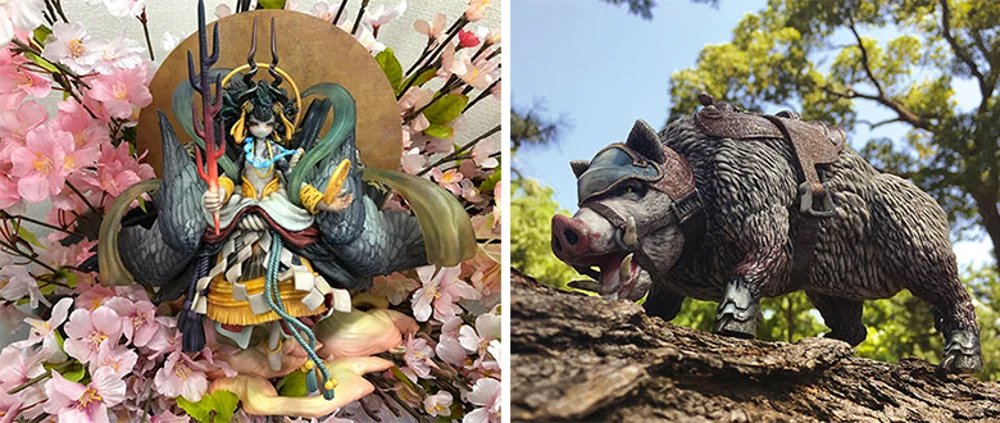
Overview
| Printer | Color Technology | Price | Layer Hight | Number of Colors | Materials | Build Size |
|---|---|---|---|---|---|---|
| 3D Systems ProJet CJP 260Plus | ProJet Color Jet Printing (CJP) | from $32,000 | 100 microns | 4.8 million | polymer powder | 236 x 185 x 127 mm |
| HP Jet Fusion 380 | Multi Jet Fusion | from $50,000 | 80 microns | not available | polymer powder | 254 x 190 x 248 mm |
| Mimaki 3DUJ-2207 | Mimaki Inkjet | From $39,000 | 30 microns | 10 Million | photopolymers, soluble support material | 203 x 203 x 76 mm |
| Stratasys J55 | PolyJet | $99,000 | 18 microns | ~500,000, Pantone validated | photopolymers | 140 x 200 x 190 mm or 22.3 liters |
Full-Color 3D Printing: The Basics
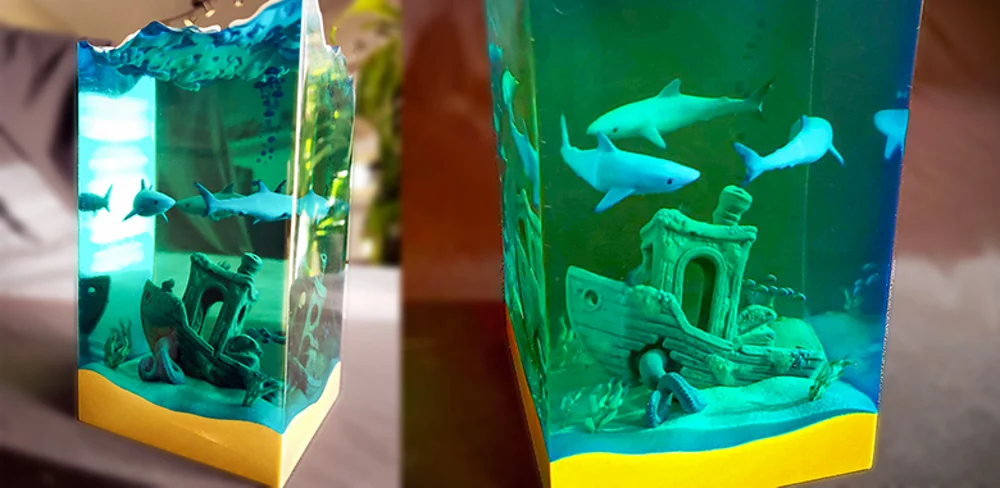
In a nutshell, full-color 3D printing is exactly what it says on the label: the ability to 3D print objects in multiple colors at once. It has been considered the Holy Grail of 3D printing, with several industries anxiously awaiting for further developments in the technology.
3D printing in color is particularly useful for medical and safety applications, in addition to toy and figurine, consumer packaging, and general industrial prototype manufacturers. Each of these industries benefits from the ability to produce high-quality parts with sharp detail in various and exact colors. Printing in color eliminates the labor and time of painting or otherwise coloring prints. Plus, parts that may experience wear, will retain their color because it’s not just surface color.
There are several technologies for achieving this result, and you should understand the differences between them if you’re in the market for a color 3D printer. Each one works differently so it’s important to consider their suitability for your particular applications to be able to pick the right printer. In fact, you could argue that comparing these printers is like comparing apples and oranges (or an apple, an orange, a peach, and a pear), but by the time you’re done with this article you should know whether you need an apple or an orange.
How Does Full-Color 3D Printing Work?
Full-color 3D printers use inks or dyes applied to color the printing material during printing or mix already colored (CMYK) materials. Each of these four printers use different color printing methods:
- ColorJetPrinting by 3D Systems
- PolyJet by Stratasys
- Multi Jet Fusion by HP
- Inkjet by Mimaki
Additional technologies for color 3D printing include methods for depositing CMYK ink on top of filament during printing, such as with XYZPrinting’s da Vinci Color and RIZE’s XRIZE. However, the ones we highlight – together with the four printer manufacturers covered here – are the full-color 3D printing market leaders All3DP has been asked most about, so we will be concentrating on them.
3D Systems ProJet CJP 260Plus
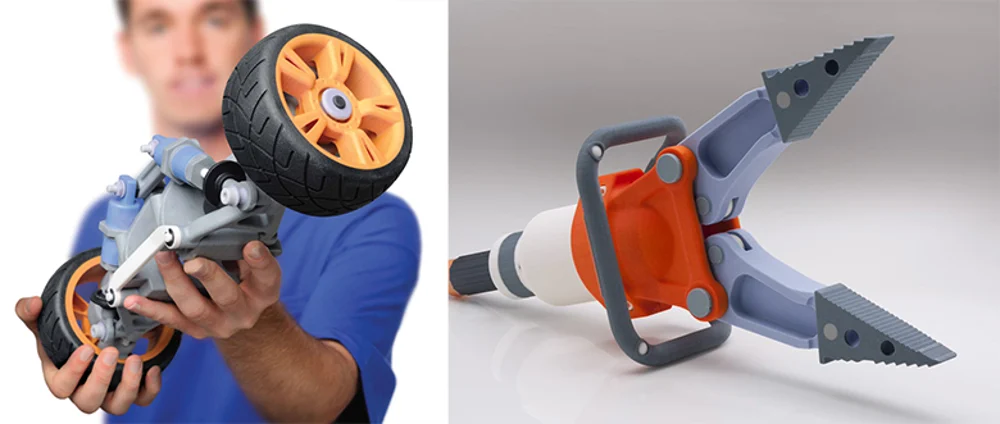
US-based 3D Systems is one of the leading additive manufacturing solutions companies in the market and offers a wide range of printers, materials, and 3D scanners serving nearly every industry.
The company’s ProJet CJP 260Plus, the smallest of its full-color printers, creates photo-realistic parts in full CMY color with small feature details and the ability to use full texture and UV mapping to better emulate the look, feel, and style of product designs.
3D Systems says its ProJet CJP 260Plus prints parts at a relatively low cost because you don’t need supports and the unused core material (a polymer powder) can be reused.
Parts can be sanded, drilled, tapped, painted, and electroplated, which further expands the options available for finished part characteristics.
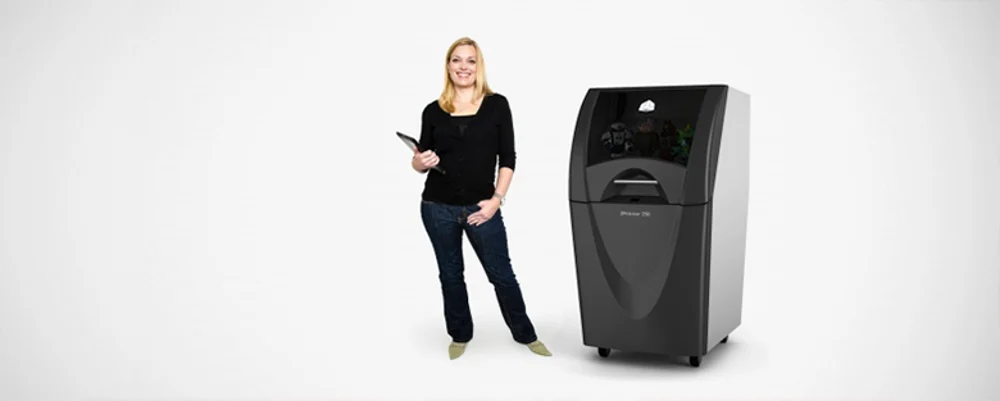
Technology
3D Systems’ ColorJetPrinting (CJP) is an additive manufacturing technology that involves a core material, which is a powder polymer, and binder. The core material is spread in thin layers over the build platform with a roller. After each layer is spread, color binders (in cyan, magenta, and yellow) are selectively mixed and jetted from inkjet print heads, which causes the core to solidify. The build platform lowers with every subsequent layer which is spread and printed, resulting in a full-color three-dimensional model. Note that there are no heat, light, or lasers used in this process.
Pros & Cons
+ Fast print speed
+ Design freedom – no supports
+ Material recycling
+ High-quality surface finish
+ Consistent mechanical properties
– Limited material options
– Small surface details may be lost
Case Study
Glassware maker ARC North America uses the ProJet 260Plus to create full-color prototypes of its latest glassware designs and shave weeks off prototyping, reducing costs by up to 90% and helping close deals, the company says. The level of detail and full-color capability allows companies and their customers to better evaluate the look, feel, and style of product designs. In ARC’s case, the ability to accurately depict designs, logos, and text that will decorate the final product is a major benefit.
3D Systems’ Other Color Printers
Introduced in 2017, the 260Plus is 3D Systems’ most affordable and smallest color 3D printer, but they have three others (460Plus, 660Pro, 860Pro) offering the same layer thickness but more colors, larger build size, and integrated part cleaning.
HP Jet Fusion 380

Technology giant HP launched its full-color Jet Fusion 380 printer in 2018 with the lofty goal of “democratizing” full-color 3D printing by offering a future-proof machine at a lower price point. The Jet Fusion 380 brings to the table more than just ideals, though.
The printer is able to produce parts with a high-quality surface finish and consistent mechanical properties. Its support-free printing method allows for design freedom and produces little to no warping in the final print, the company says.
Jet Fusion 380 recycles some of the used material during its regular printing process, and more of the powder can be recovered during post-processing. Combined with a low individual print unit cost and a fast print process, it is a great choice for those looking to produce multiple design iterations or small batch prints.
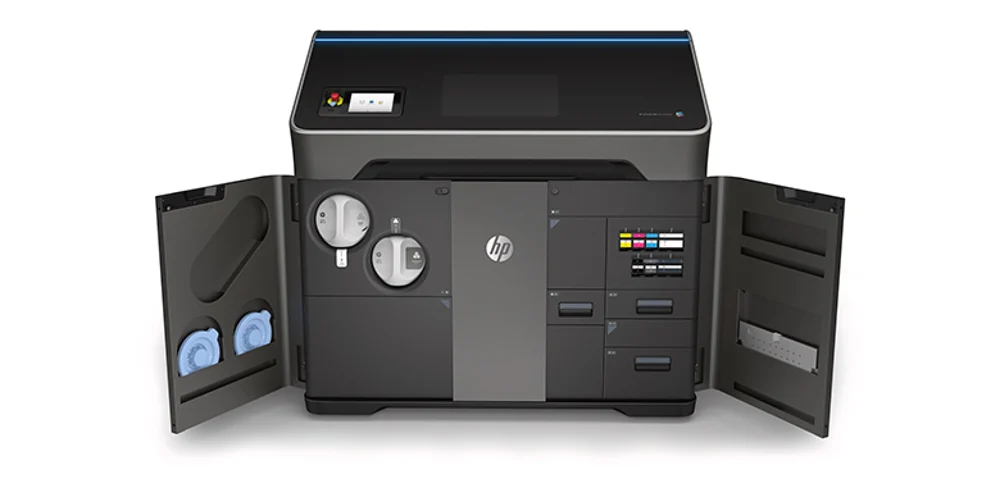
Technology
HP’s Multi Jet Fusion technology is relatively new, but it has matured quickly over the past few years. The printer lays down a thin layer of powdered plastic material, over which inkjets dispense fusing and detailing agents to create the desired geometry.
The layers of powder are melted together with an infrared power element in each cycle. Color is achieved by injecting inks onto the powdered printing material at a voxel level through inkjet heads – much like with HP’s inkjet 2D printers. So the 380 has CMYK inkjets able to produce colors in the full CMYK spectrum in addition to the agent inkjets.
The 380 also supports the 3MF file format for skipping the slicer and comes with the HP SmartStream 3D Build Manager and Command Center software.

Pros & Cons
+ Fast print speed and cooling time
+ Design freedom
+ Material recycling
+ High-quality surface finish
+ Consistent mechanical properties
– Limited material options
– Prints require post-processing
– Small surface details may be lost
Case Study
Sant Joan de Deu Hospital used HP Jet Fusion 580 to print out superhero figurines designed by their pediatric patients. The technology helped the children work together with world-class cartoonists to create six highly detailed, full-color 3D printed statuettes of completely original superheroes.
HP has also co-developed color applications with universities and businesses around the world including Phoenix Children’s Hospital, Yazaki Corp., and Youngstown State University, amongst others. Oakley, the sportswear brand, has also adopted HP’s Jet Fusion technology to iterate and test various designs and create faster, cheaper, and more lightweight products like sports performance eyewear, helmets, and trophies.
HP’s Other Color Printers
Offering exactly the same features as the HP 380 is the 580, which features a larger build volume; 332 x 190 x 248 mm.
Mimaki 3DUJ-2207
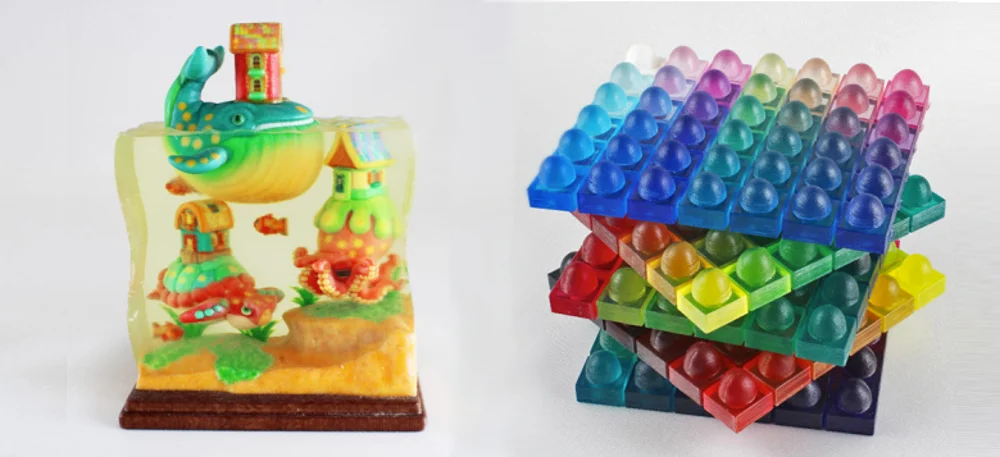
Mimaki, founded in 1975, has a long history in 2D color printers. The company’s 3DUJ-2207 is the youngest of our four printers, having arrived on the market just in the beginning of 2021. (The company’s larger full-color machine, the 3DUJ-553, has been on the market since 2017.)
The Mimaki 2207’s color system enables it to produce more than 10 million potential color combinations, in addition to translucent and transparent parts. Its waveform control, circulation, and variable dot technologies ensure stable and precise ink delivery with smooth, finely detailed color reproduction.
Based on Mimaki’s previous printers, the 2207 provides a more compact option than the Japanese firm’s older machines. It can be loaded into an elevator without disassembling, has a small footprint and a quiet design with a deodorizer, making it very office friendly.
Its water-soluble support material allows for easy post-processing, and as an additional bonus, the printer features a camera for live printing status checks.

Technology
Mimaki’s proprietary technology was originally developed for its 2D UV flatbed printers. It uses inkjet print technology to deposit UV-curable liquid resin in white, clear, and CMYK, along with soluble support material on a bed layer by layer. Each layer is cured by the UV light.
The machine uses white or clear liquid resin as the base material, then it instantly jets color to coat the base. After it’s completed, a roller flattens the material layer and the process repeats until the print is finished.
The Mimaki technology is able to achieve a wider range of colors than any other in our list, which is ideal for skin tones, as you can see in the video below, and fine art.
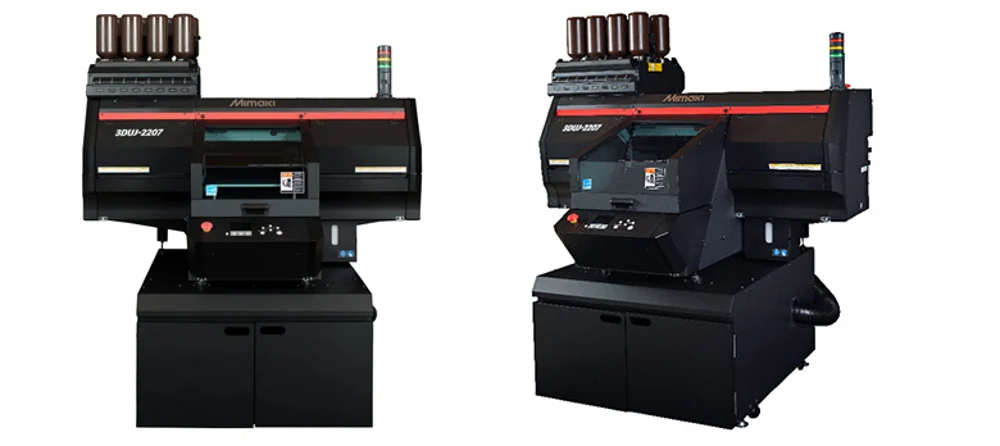
Pros & Cons
+ Superb color reproduction
+ Comparatively affordable machine
+ Good print detail
+ Water-dissolvable supports
+ Small footprint good for office environments
– Required supports
– Only prints in one material
Case Study
Since the 3DUJ-2207 is a brand new printer, Mimaki does not yet have detailed case studies publicly available, but the 2207’s technology is the same as their larger printer, the company says, so check out this video case study of the 3DUJ-553 below.
Stratasys J55

In the 3D printing business for just over 30 years, Stratasys offers more than 20 3D printers spanning three technologies, not including those from its popular subsidiary MakerBot.
The Stratasys J55 is the company’s latest addition to its PolyJet J-Series 3D printer range. The machine is compact enough to fit almost any office space (the smallest in our comparison), and it brings some exciting features to the product line.
Stratasys says its rotating print platform in the J55, with a static print head, delivers consistent material jetting and fast print times, and it’s able to deliver truly impressive printed details at 18 microns. It also features multi-material printing, so you can incorporate up to five different materials into a single print run.
The Stratasys J55 is the only printer in our list with the multi-material option, giving you access to a palette of colors, textures, and gradients in the same printed parts. You’ll be able to imitate a variety of textures, from wood to fabric. It is also able to produce 500,000 colors and 2,000 Pantones, and is even able to print transparent objects to simulate glass and plastic, making it an attractive option for prototyping. Stratasys’ J55 can also print with VeroUltraClearS, which is one of the clearest simulators of glass and plastic on the market.

Technology
Stratasys uses its proprietary PolyJet printing technology in the J55. The process uses liquid resin dispensed through inkjets. Photopolymer material in CMYK colors is added to the print bed layer by layer. In between, each layer is cured with UV light, allowing the user to adjust the transparency of each color.
As far as software is concerned, the J55 uses the Stratasys GrabCAD, which enables you to print directly from this CAD software without the need to convert and fix STL files. The J55 also supports the 3MF file format so you can directly 3D print in full color and multi-material textures directly from KeyShot 3D rendering software. This technology can save a lot of time.
It’s also worth noting that the J55 is office-friendly with a compact size and it’s also very quiet at 53 decibels (about the same as a household refrigerator).
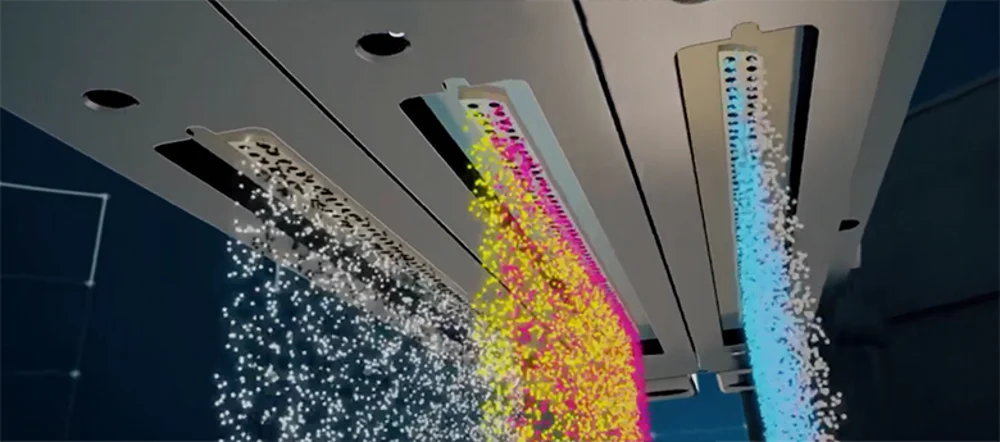
Pros & Cons
+ Extremely fine detail
+ Multi-material capability
+ Compact dimensions
+ Color definition on the digital model
+ Little post-processing required
– Requires support structures (although they’re hands-free and soluble)
– High printer and material costs
Case Study
Cincinnati, Ohio-based product development firm Kinetic Vision faced the challenge of developing an alternative to traditional consumer liquid packaging solutions. Using the J55, Kinetic was able to deliver prototypes of the new packaging with semitransparent, full-color graphics printed directly on the part.
Priority Design, another Ohio-based product developer, harnessed the J55 to design and prototype a new type of handle for garden pruning scissors. The printer allowed the company to quickly create multiple iterations of new handles and reduce post-processing significantly by printing colors and graphics onto the prototype.
Stratasys’ Other Color Printers
The J55 is Stratasys’ entry-level color printer. The company’s J8 series (J826, J835, J850) all feature Polyjet technology and 500,000 colors but offer higher resolution, more material variety, faster speeds, and larger build volumes.
Materials for Color Printing

Let’s take a closer look at the materials that go into each of these machines because they are certainly not interchangeable. More importantly, materials play a significant role in the cost to run your machine so keep in mind how many materials, coatings, sealants, and inks you’ll need and their cost.

3D Systems uses a base material called VisiJet PXL in all of its color printers. It is a type of plastic powder, and what’s interesting about this material is that you can coat it with three distinct toppings (ColorBond, StrengthMax, and Wax) to change its properties. For example, VisiJet PXL plus the company’s ColorBond quick-curing coating makes strong and vibrant prints. In fact, 3D Systems even provide mechanical specs for their materials, such as tensile strength, elongation at break, flexural strength, etc. Each of these stats will change depending on the coating.
There’s a fourth coating option called Salt Water Cure, which is eco-friendly and economical, but it’s only for monochrome prints.
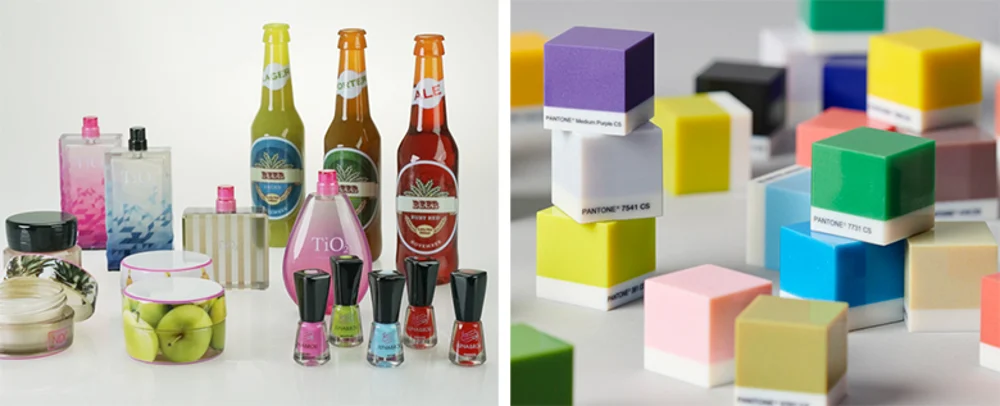
Stratasys color printers use liquid photopolymers, similar to resins, in CMYK that, when combined, create colors similar to an inkjet printer. The material is called VeroVivid and when you combine it with the company’s other materials, such as Vero white, black and clear shades, allow for any transparent or opaque combination. Materials in the Vero family share similar mechanical and thermal properties and Stratasys does offer mechanical specs, including shore hardness, water absorption, tensile strength, etc. For quick prototypes, Stratasys also offers the DraftGrey, rigid material with medium opacity and smooth finish, for the J55.
Mimaki takes a two-material approach that includes UV-curable liquid resin (in white and clear with CMYK inks) and water-soluble support material. The company says its resin ink has the same strength as ABS, making it possible to drill holes and attach screws. In addition, overcoats can be used on the final prints to create different looks.
HP color printers use a single engineering-grade thermoplastic powder base material, binding agents, and coloring agents combined to create its color prints. The base material is PA 12 also called nylon 12, which comes with mechanical stats for strength and flexibility.
Post Processing and Polishing
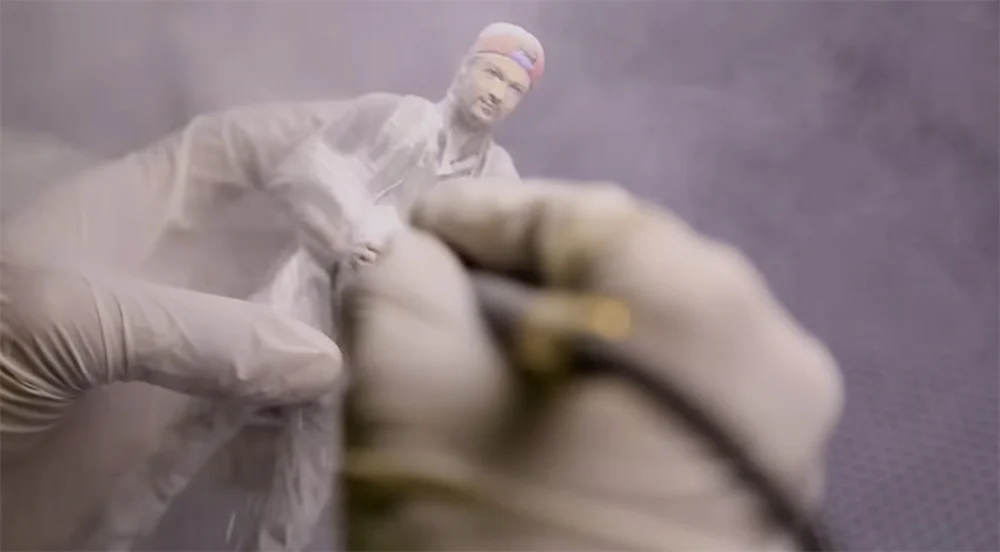
Once your color part is finished printing, you’re not done. There’s typically some post-processing and polishing to get the desired vibrancy and texture. How complex and time-consuming this process is depends on the printer and technology. Let’s take a look.
The two powder-bed technology solutions we explore, 3D Systems and HP, require that leftover powder be removed from the final print. First, your part from the HP printer has to cool while the 3D Systems printer doesn’t use heat so there’s no cooling involved. Then parts are removed from the bed of powder they’re in, then polished and optionally coated with a sealant that brings out the colors.

The HP 380 printer automatically sucks the excess powder building material back into the system for reuse, but you then need to have a cleaning station like one of the ones pictured above where you can clean your prints by hand with bead and air blasting.
The 3D Systems ProJet CJP 260Plus is potentially a bit messier in that it doesn’t reclaim the unused build powder in the printer (the company’s other color printers do have an integrated cleaning system). With the 260Plus, you have to move the entire powder bed to a depowdering station, remove the print from the powder, let the station reclaim and sort the excess powder, then clean the print. 3D Systems offers its own Core Recycling Station (~$12,000) and Cleaning Station, but you can pair it with other brands of cleaning stations.
Stratasys and Mimaki use liquid plastic technology, so you don’t dig parts out of a bed of powder. Instead, after printing you easily dissolve the supports in water. Then, with both Stratasys and Mimaki, there’s just some minimal cleaning and polishing required and optional sealants.
Category Winners

Each of these printers shines in its own niche, and they are all great choices for full-color 3D printing. However, not everyone can be great at everything. Let’s take a look at who takes the lead in color reproduction, print detail, and printing speed.
Best Color
The Mimaki 3DUJ-2207 has the ability to produce a mind blowing 10 million color combinations and has the least of the whiteish top layer that all four printers produce (although add a polishing step and this is not an issue). In fact, none the competing printers can reach Mimaki’s number of colors, which enables an amazing range of subtle variations of skin tones and finely tuned color gradation that you can see in the life-like figures above. Mimaki adheres to the standards of the International Color Consortium so your color results pretty much guaranteed to be consistent no matter which Mimaki 3DUJ-2207 printer you use. Stratasys also offers Pantone verification on nearly 2,000 colors so you’re guaranteed to have a final part that is an exact Pantone color, but we’re going to call the category color here for Mimaki!

Best Print Detail
The Stratasys J55 takes the cake in print detail with a layer thickness of only 18 microns, yet Mimaki comes in second place with 30 microns. Certainly, the J55’s detail leaves the Jet Fusion 580’s 80 microns-thick layers and the 3D Systems’ 100 micron-thick layers in the dust. The fine detail contributes to how well the J55 can simulate different material finishes, such as rubber, fabric, wood, etc.
Best Printing Speed
Declaring the victor is not as straightforward when it comes to printing speed. A lot depends on what you’re printing so its worth giving manufacturers an example of what you expect to print and they should be able to give you a rough estimate in hours.
HP reports the Jet Fusion 580 can complete a full-chamber build job in 12 hours at a print speed of 1,817cm3 per hour. 3D Systems says its maximum vertical build speed is 20 mm per hour.
Stratasys does not report printing speed for the J55, but the printer is able to cut printing times by producing multiple parts lined up over the print head pass without affecting the total time. Mimaki only reports that the 2207 is 3 to 4 times slower than its larger 3DUJ-553 printer.
Due to the lack of clear information, we are calling this race for the HP Jet Fusion and 3D Systems!
Full-Color 3D Printing Services

Although having one of these impressive printers in your office or workshop will no doubt be a great benefit for any company, they do all require a significant up-front investment. As such, buying a full-color 3D printer may not always be financially possible. If you’re simply looking to complete a one-time or occasional print job that doesn’t warrant buying a machine of your own, there are many third-party printing services that do own these fantastic machines.
Finding the right company for your needs can be a challenge, though, so using a 3D printing price comparison service, like FacFox, is an easy way to shift through the metaphorical haystack to find the needle you’re looking for.
Credit: Ile Kauppila